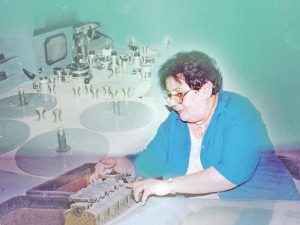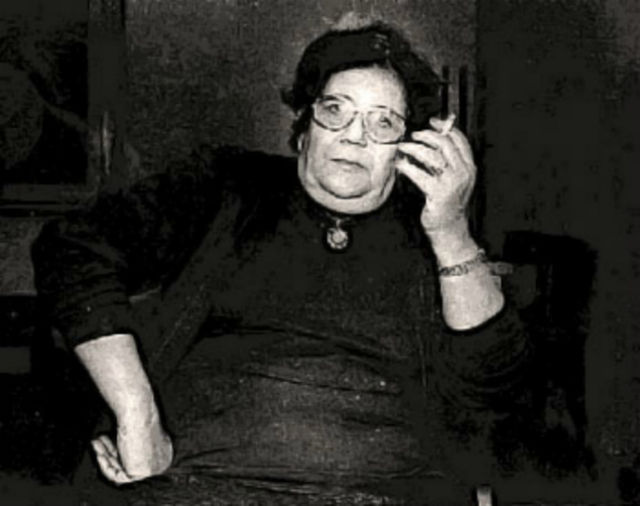Rachida Abdel-Salam
1932 – 2008

Rashida Abdel-Salam was an aspiring actress but, as she put it, “I couldn’t be an actress because I can’t roll my R’s properly, so I found out about editing.” It was a valuable discovery: Between 1959 and 2004, Abdel-Salam edited thirty-six films for some of the most celebrated Egyptian directors, including Youssef Chahine (including Destiny/Al-massir, The Emigrant/ Al-mohager, and Silence… We’re Rolling/Skoot hansawwar), Hussein Kamal (Something to Fear/Shay’ Min Al-Khawf), Helmy Rafla (Mabodet el gamahir) and Henry Barakat (Shame/Al-Haram).

“The directors are known: they’re the bosses. The scriptwriter: well, he’s a writer. The actors are known, even the set designer and the make-up artist are known. Their jobs are easy to understand. But film editing? No one knows about editing. You would have to write a book about it.”
“Some people can’t write unless they have a pen in their hand. They have cramps in their wrist, it’s a painful thing, but they love it. When a writer breaks off to sharpen his pencil, there’s a moment of thought: you dream for a second. It allows you to continue, to begin creation anew. It’s the same for me: when I pause to mark the film for cutting, my mind keeps working; I am actually deciding what the next step will be.”
—Two extracts from “Rashida Abdel-Salam: Real to real” by Pascale Ghazaleh. The full text can be found in the Appendix




Helen van Dongen
1909 – 2006
 Helen van Dongen was a pioneering editor of documentary films, active from 1925-1950. A key collaborator with Joris Ivens, she edited The Bridge, The Rain, The Spanish Earth, and others. Later, working with Robert Flaherty, she edited The Land and co-produced and edited Louisiana Story. Van Dongen also produced several newsreel compilation films on her own, including Spain in Flames and Russians at War.
Helen van Dongen was a pioneering editor of documentary films, active from 1925-1950. A key collaborator with Joris Ivens, she edited The Bridge, The Rain, The Spanish Earth, and others. Later, working with Robert Flaherty, she edited The Land and co-produced and edited Louisiana Story. Van Dongen also produced several newsreel compilation films on her own, including Spain in Flames and Russians at War.

“In the early days filmmakers, aside from having to be good camera men, simply had to be editors. There was no play or no dialogue to depend on. It was purely and simply a visual development, knowing how to read the content of a scene, knowing where it wants to be in a film because of its inner content, the juxtaposition it need to other scenes to reveal its full value. That, essentially, is filmmaking. So I consider myself a filmmaker, not just an editor.”
—“Helen van Dongen: An Interview by Ben Achtenberg and Helen van Dongen” in Film Quarterly. The full interview can be found in the Appendix.

“You will be led astray if you try to impose your will or your theory on a scene. You really have to go from image to image and see what each image is telling you….When you scrutinize image after image, what these images are telling you has a lot to do with your own ideas because ideas determine what an image tells you….It is not our task to tell the audience what we are thinking but to show them what we have discovered in these scenes as reality. All we can do is to turn the audience into observers so that they see, that they think, and then form their own opinion.”
—Three excerpts from an interview in “Schnitte in Raum und Zeit by Gabriele Voss. The full text can be found in the Appendix.







 Helen van Dongen was a pioneering editor of documentary films, active from 1925-1950. A key collaborator with Joris Ivens, she edited The Bridge, The Rain, The Spanish Earth, and others. Later, working with Robert Flaherty, she edited The Land and co-produced and edited Louisiana Story. Van Dongen also produced several newsreel compilation films on her own, including Spain in Flames and Russians at War.
Helen van Dongen was a pioneering editor of documentary films, active from 1925-1950. A key collaborator with Joris Ivens, she edited The Bridge, The Rain, The Spanish Earth, and others. Later, working with Robert Flaherty, she edited The Land and co-produced and edited Louisiana Story. Van Dongen also produced several newsreel compilation films on her own, including Spain in Flames and Russians at War.

